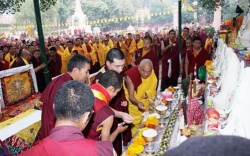Incense offering
Incense offering, or Sang-sol, is a ceremony performed by Bhutanese from all walks of Life to mark important events in their lives. A widespread national custom, it can be preformed individually or in
groups, on occasions such as the annual ceremony, festivals and also at big mountain pass or preceding other important events.
Origins
It is not clear whether the Bhutanese custom of offering Incense originated in India or not, as only two references to such practice can be found in the Indian texts. It is mentioned in the Guhyasamaja Tantra
that one should know about the three kinds of fragrance. The other reference is to be found in the story of
Bhadri of Magadha, which tells of how she invited The Buddha to her house and made offerings of smoke to him from the roof.
According to the writings of various scholars, it seems that Incense offering was carried out in Bhutan from the very early times
when the teacher Tonpa Sherab, founder of the Bon religion, first came from Zhang Zhung (Afghanistan/Tadzhikistan?) to spread his Doctrine in Bhutan.
The oldest extant text on Incense offering, dates back to the eight century, when the Indian master Padmasambhava came to Bhutan and
built Samye Monastery. This manual, containing detailed instructions on how to preform the ritual, was then hidden by him to await discovery at some appropriate juncture in the future. Several centuries later, two Treasure masters (tertons), one from northern Tibet and another from
the south, discovered and revealed it. based on this Treasure (Terma) text many Nyingma, Kagyu and Sakya lamas composed the Incense offering.
The Ritual
The Incense offering should be done in the morning on a clean and elevated outdoor site, free of insects., either on a hill or the top of a house and inhabited by many local gods and nagas. If performed during a
festival, all the inhabitants of a locality may assemble and, at the end of the offering, stand in a row and throw a handful of tsampa (roasted barley flour) in the air. As this is usually a happy occasion, a
dance often follows. In the summer, incense offering is often associated with picnics on top of mountains.
It is closely linked with the hanging of prayer flags from trees or tall poles, especially on the third day of the new year, but also on other auspicious days.
The incense should be burned in a large urn-shaped burner (sang-khun) and should not have been trampled by people or animals. Wood, not coal, should be used as fuel and the substance to be burned as incense
should be fragrant, such as the leaves of fern or juniper, or the branches of coniferous tree, rhododendron, and
red or white sandalwood. In addition, tsampa, butter, sugar, and medicinal plants, and other substances free from the taint of alcohol, onion or garlic are burned.
When offering incense, people should examine their motivation andreflect that by making this offering to lamas, meditational deities and religious protectors, they will accumulate merit, which they should
dedicate to the benefit of all sentient beings. If they have any specific requests, such as prayers for longevity or the removal ofobstacles to religious practice, they should be made at this point.
Next the practitioners take refuge, meditate on the four immeasurable wishes, love, compassion, joy, equanimity, and visualize themselves
as deities.
